Welcome to a new issue of the Journal of Runic Studies, the premier Malkioni publication for studies into the nature of Glorantha. If you haven’t subscribed yet, please consult with the spirit bound to the appropriate electronic page.
God Learner Sorcery
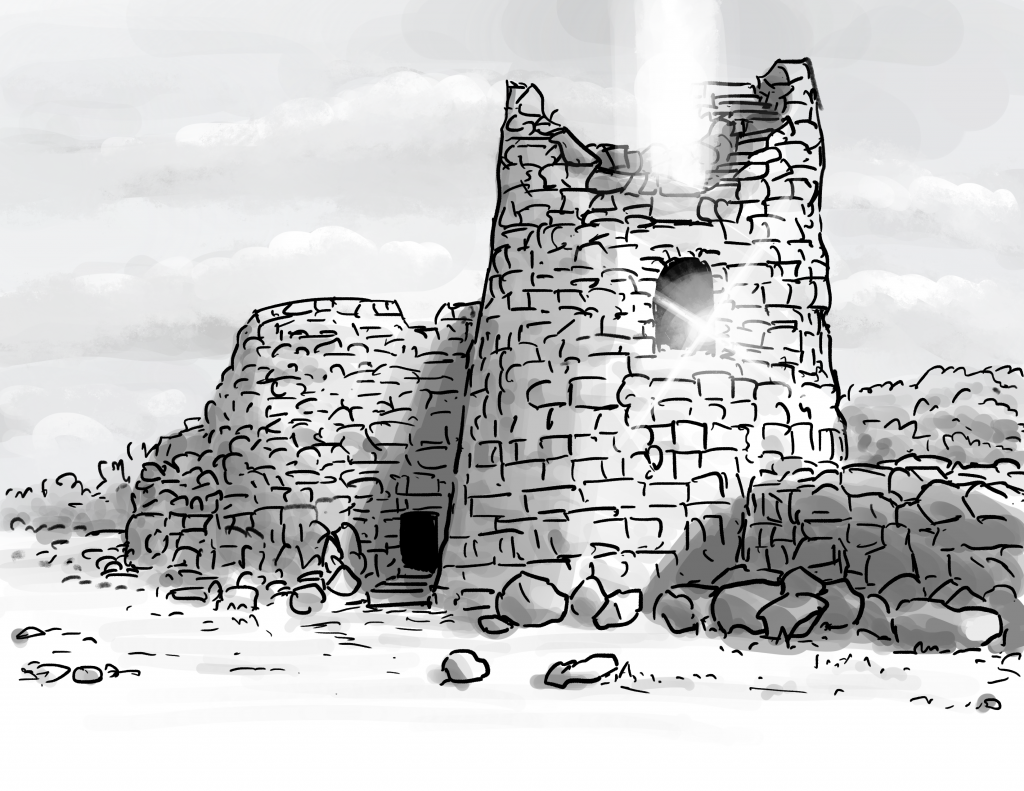
We are now occupying a nice little tower with a long history of previous occupants who have left behind documents, tablets, artifacts, and other kinds of junk. As we clean up and archive these things, we share the most interesting ones with you.
Found Documents: Small Story Collection
Diana/Berra got the prompt for her wonderful “Small Stories” blog post (also featured later in this issue) from the Chaosium Discord, so I think it’s fair if we also grab it and run with it? We have our own first micro-fiction here. Here’s an example:
A brick in the back of the temple caught my attention. It featured the unmistakable prints of an alynx’s paws and buttocks, with a surprisingly well defined anus. I asked the builder about it and he said that one of the city’s felines was indeed responsible for this. The animal sat on a brick one morning while the brick (and many others like it) was drying in the sun. He did admit using his chisel to enhance the print, so he couldn’t really blame it all on the alynx. I asked him why he did that. He told me that the temple’s priest was “a bit of an asshole”, and that therefore his temple should have one too.
Excerpt from the travelogue of Olerian Marania
Chaosium News

Here are this week’s Chaosium news!
The RuneQuest Starter Set Gets a Date
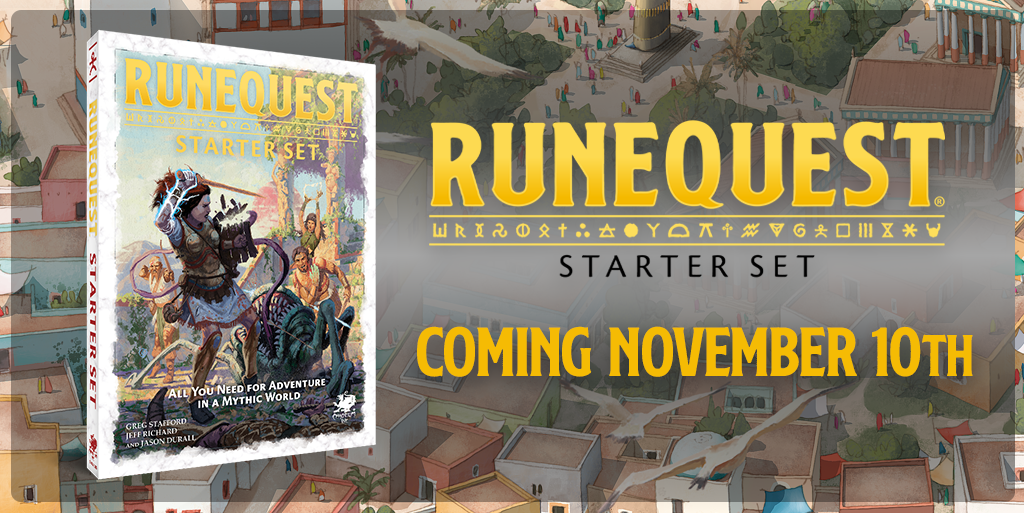
Looks like we finally have a date for the release of the RuneQuest Starter Set! It will be available for order on November 10th. Tell your friends! Tell your FLGS!
Jason Durall even wrote a short blog post with some anecdotes and pictures from the Kraken and the Polish warehouse of Black Monk Games (which is now officially in partnership with Chaosium’s more-or-less “parent company” Moon Design Publications, by the way).
Katrin Dirim Gets a Well Deserved Award
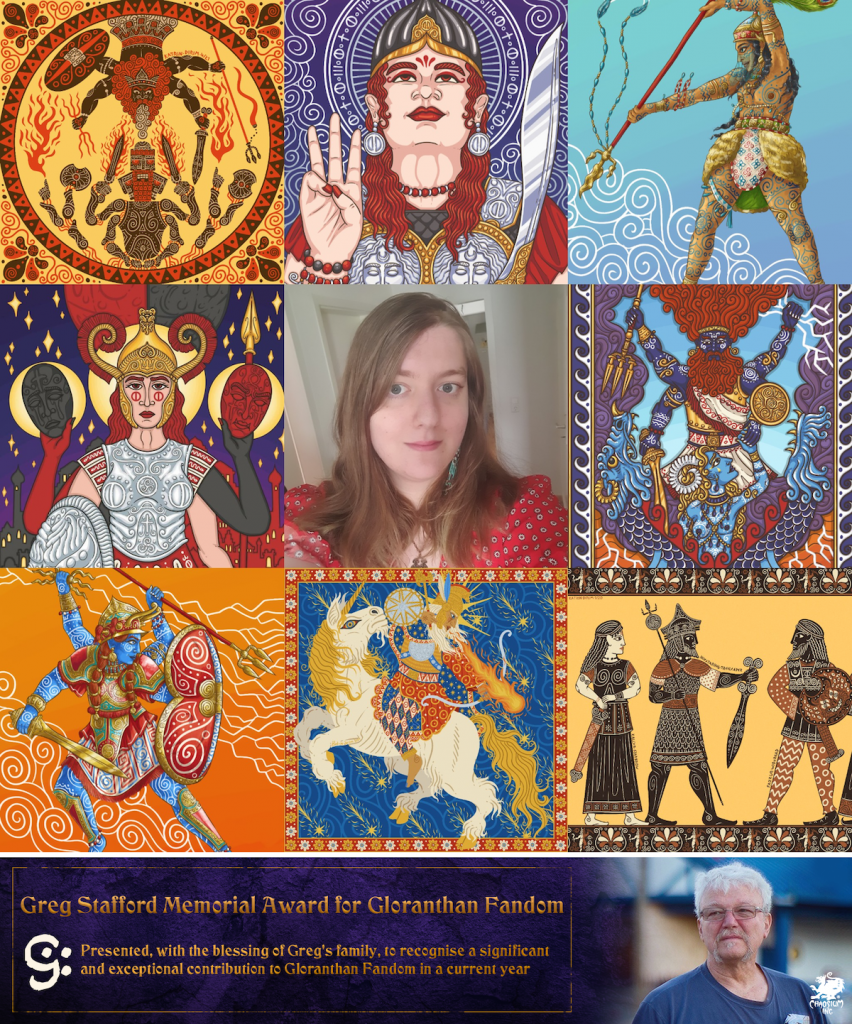
Fabulously mythical artist Katrin Dirim, whose work graces many pages of both official and non-official Glorantha material, is the 2021 recipient of the Greg Stafford Memorial Award for Gloranthan Fandom! Congratulations Katrin!
The Chaosium blog has a short biography of Katrin, along with her acceptance speech.
Previous winners of the award include Lev Lafayette, Martin Helsdon, and Nick Brooke.
What’s New With RuneQuest?
This is not really official Chaosium news, but it involves Chaosium employees talking about Chaosium products, so it goes here!
The Kraken convention, which took place two weeks ago (Joerg was in attendance!) has put out their first panel video, which features Jason Durall, and Neil Robinson talking about RuneQuest.
It starts with the RuneQuest Starter Set, which we already know pretty much everything about by now. Later in the video, however, Neil points at the several pandemic-related problems that have affected production and shipping, such as shortages in paper and cardboard, delays at borders, and so on, not even counting the VAT headaches between boxed products and game books. We also later learn that the SoloQuest adventure in the Starter Set will be published online so that people can try it for free in their browser! That’s a very cool idea.
Jason follows quickly with what’s in the pipeline:
- The Weapons & Equipment Guide seems to be the next release.
- The Sartar Homeland Set is well advanced, and a bunch of other Homeland Sets (Esrolia, Lunar Tarsh, Grazelands, Prax, Heortland) are still in writing.
- The cults book is a slipcase set, about the size of the core rulebook one. The main two books are illustrated by Loic Muzy and Agathe Pitie. The third book is the prosopaedia and is apparently about 130 pages, which is longer than expected originally. As such, it has gained Katrin Dirim as not only the illustrator but also graphic designer.
Jason mentioned that the cults books are pushing the “standard” RuneQuest graphic design to the next level, which means that future books will get more pretty and more ambitious in terms of layout.
Chaosium is considering releasing smaller products (possibly PDF-only) in between the big book releases, such as a collection of non-human adventurers for use with the Starter Set. They’re also looking at releasing card decks for RuneQuest (Rune and Spirit Magic, monsters, encounters, etc.), similar to the Call of Cthulhu Keeper Decks.
Eventually there will be updates to Elder Races. For example we know Shannon Appelcline is working on an “Elfpak”, but there will be books for Trolls and Dwarves and so on obviously. Maybe even Dragonewts, as Jason and Neil were hinting that just because these races are “strange and unknowable” doesn’t mean RuneQuest players can’t handle them correctly for their own Gloranthas.
Jason has more than a dozen adventures that have gathered up on his desk and will probably see the light in a new scenario collection similar to the two that are available right now.
Jonathan Tweet’s RuneQuest book, “The Dragon’s Eye“, is still in progress. However, it looks like the “Glorantha May Vary” aspect that was originally pitched (where various locations and figures would have several possible backgrounds and gaming avenues for gamemasters to pick) has been dialed down. This is now a collection of detailed adventure sites with just sidebars for possible “variations”, which was deemed a more practical and usable approach.
The Gamemaster Guide is still ongoing, with one of the hold ups being ironing out the Battle rules (these were previewed in Jeff’s game on YouTube and I extensively annotated them in a previous Journal issue). The chassis is Pendragon’s Battle system, but it needed some changes to work with Earth-elemental-summoning priestesses and Flying warriors sending Lightning Bolts onto enemies. Jason’s goal is to make this Gamemaster Guide fit in the core rulebook slipcase where the Gamemaster Screen Pack currently is, but of course he has to deal with too much cool stuff that makes the page count balloon up.
The heroquesting rules have been delayed due to the pandemic, as the principal writer Chris Klug had shifting priorities with his day job. Jason sounds pretty excited about the mechanics, which include a way to assemble a heroquest using some kind of building blocks. Because of that, Jason is aiming for a boxed set where these building blocks would take the form of cards we can use at the table. The aforementioned Gamemaster Guide will most probably have a very lightweight form of these rules — it was supposed to have the full rules, but Jeff delivered too much material to fit in there.
Robin Laws’ Pavis & Big Rubble manuscript has moved to editing.
On the digital side, in addition to the online SoloQuest adventure, Chaosium is working on a small Glorantha wiki that is targeted at new players and game support. Keep in mind here that it won’t have the “openness” of traditional wikis (only Chaosium people will be able to edit pages), and that it’s meant to be minimal rather than exhaustive. It will include basic lore information, “fast” character creation “packages” to more quickly create RuneQuest characters, spell references, and so on. It sounds like this new infrastructure will be used for other Chaosium settings besides Glorantha, too, and that it’s a key part of Chaosium trying to catch up to the wonderful online support you can find in other game systems (Neil mentioned Pathfinder here).
Finally, now that Chaosium has acquired the Dhole’s House, a very popular character creation website for Call of Cthulhu, they’re looking at offering similar tools for RuneQuest in the long term.
That’s it! Phew! Gianni Vacca has his own comments on the panel over at his blog.
QuestWorlds Update
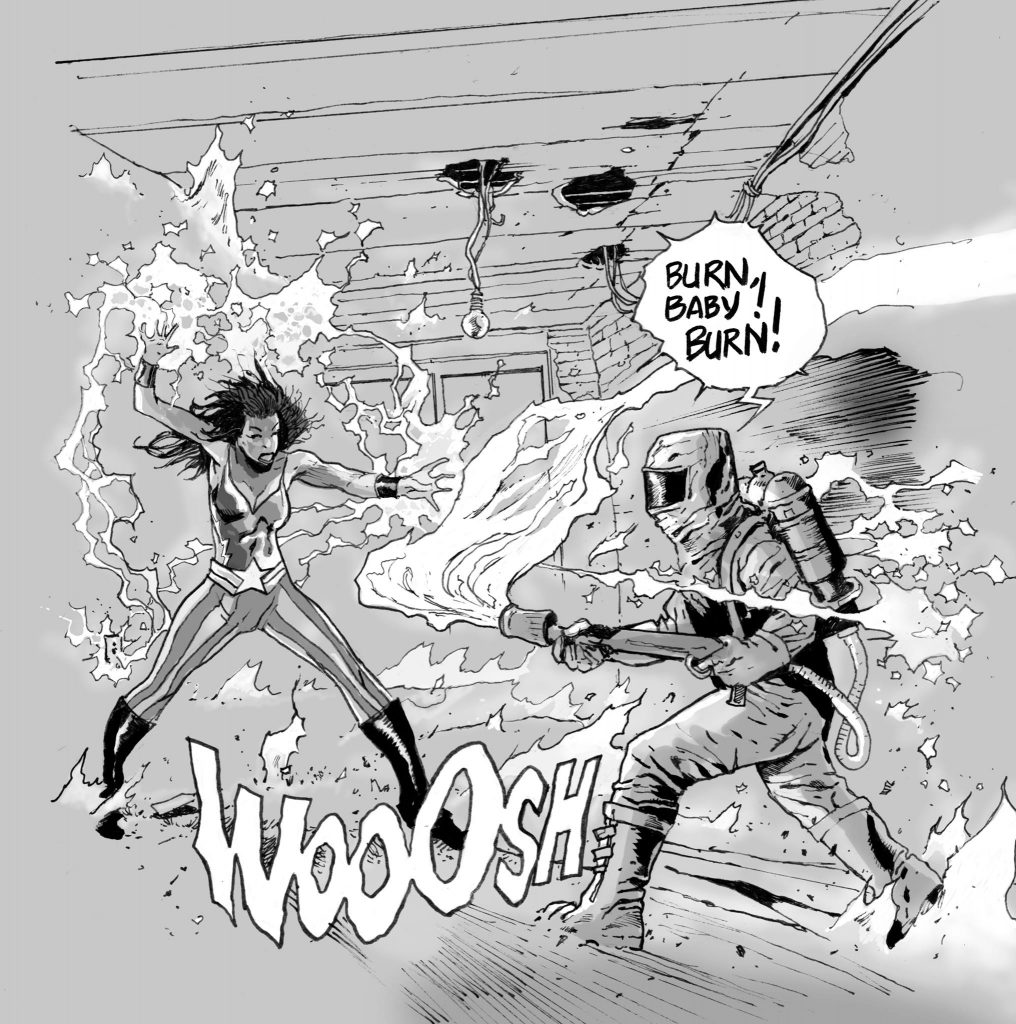
The Chaosium blog has a short update on the new QuestWorlds book! It features a bit of art and some excerpt from the rules. This is the system that first appeared as HeroWars and later HeroQuest, for Glorantha, but the new edition will be generic, featuring only some custom “example” settings such as super-heroes and science-fiction.
The blog mentions that the mechanics “remain unchanged” from HeroQuest, but last time I checked the SRD, there were enough changes that I would describe QuestWorlds as HeroQuest 2.5. Pretty much all of those changes are great in my opinion, as they strive to simplify and unify parts of the system that were previously unclear or fiddly — Ian Cooper ran many open design discussions online and it was always very interesting.
Jonstown Compendium

The Jonstown Compendium is Chaosium’s community content program for all Gloranthan games, hosted on DriveThruRPG. Disclaimer: all the relevant links are affiliate links that hopefully will let us cover some of the hosting and maintenance costs for the website and podcast! Thanks for using them!
Sandheart Volume 4: The God Skin & Mad Prax

The fourth and last volume of the Sandheart series is now out! It contains two scenarios, one by the main series writer Jon Webb, and one by Michael O’Brien. Many other people contributed (disclaimer: I did a tiny little bit, as with the other Sandheart volumes) so there are many names to credit but hey, the best way is to go buy and read it!
The Salt Man
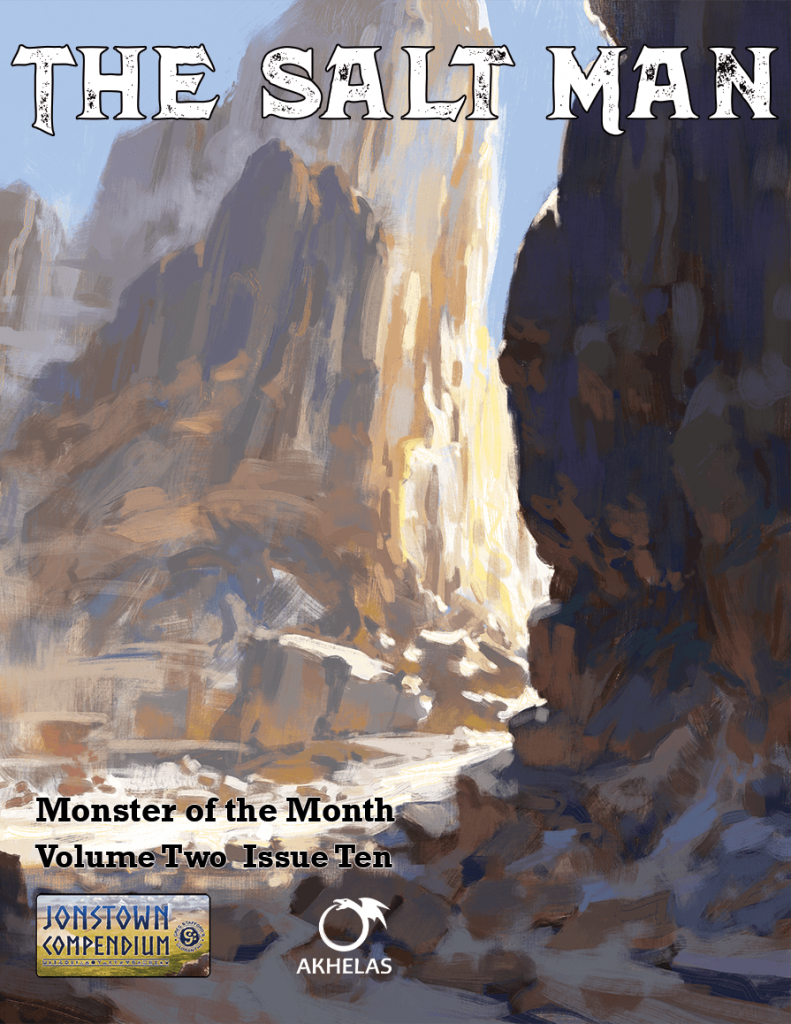
This month’s Monster of the Month entry has been released and it’s The Salt Man! A Praxian abomination that shouldn’t exist! Learn about it, worship it, fight it, propitiate it, deal with it!
Corallo’s Artpack #3: The Seventeen Foes of Waha
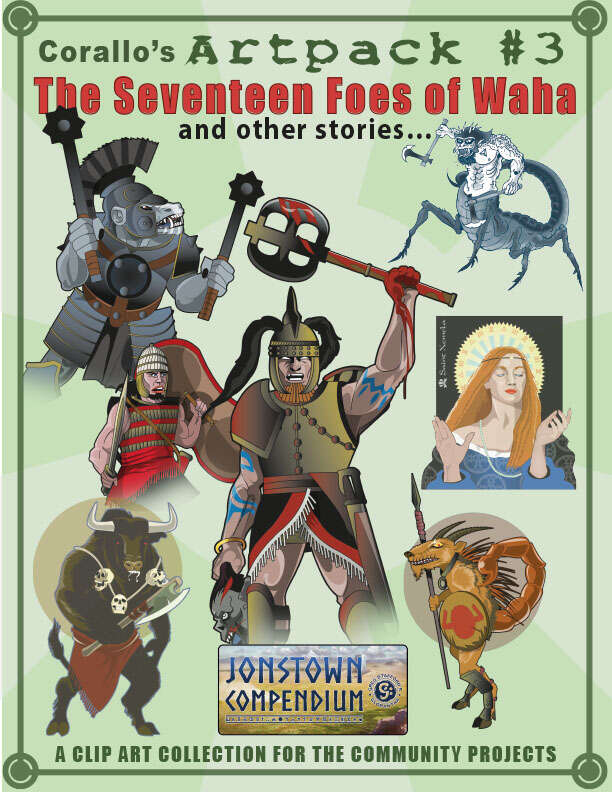
This is another one of Dario Corallo’s “artpacks” for use by Jonstown Compendium authors or, I guess, gamemasters with free time to make fancy handouts. This one contains all the titular foes of Waha, plus a few extras. Besides the other artpacks, Dario also has a whole bunch of stuff such as VTT counters for use in online gaming.
Jeff’s Notes

Jeff Richard, the current mastermind on everything Gloranthan at Chaosium, is often posting notes and thoughts on the RuneQuest Facebook group. Here’s our curated list from the past week. A partial archive of these sources is compiled on the Well of Daliath.
Orlanthi Marriages
A question on the RuneQuest facebook group prompted Jeff to give quite a few interesting answers about marriage and children in Sartar.
First, when two people of different clans and tribes get married, they stay members of their respective clans. As they live together, one might of course be outside their clan’s territory, but their belonging to their original clan creates very important ties between these clans. These ties might even be more important when these two clans end up on the verge of a feud.
[…] remember that you know these people. You are related to them. Sure you belong to the Jereni Bird clan, but dad is from the Duroli clan, and so are your uncles and favourite cousins. And if you have a problem, you might also go to the Duroli clan for assistance.
Clans are not hermetically sealed like they were presented in Thunder Rebels!
Figuring out who goes where and what clan the children will belong to depends on the type of marriage. This is all explained in RQG p427, but these are just guidelines. Personal experiences and practical matters add a lot of deviation:
[…] I think there is a larger communal role in child-rearing than we commonly would assume in Western culture. So ambitious Ernalda initiates might have their first child quite young, and that child is reared by the extended family more than by the initiate.
Joining a Clan
Speaking of clans, there were also a few questions about joining or “being adopted” into one, which Jeff addressed:
Although every clan traces its origin to a common founding event, spirit, or other occasion which forged the clan, outsiders can and often do join a clan. This is so common that many clans only have a minority of members with biological kinship to that original founding. A new member must be “adopted” by another member (often a clan leader) and swear loyalty to the clan ring, placing themselves under its protection and promising to support the clan against all others. The new member is brought into the clan cult and becomes at least a lay member of the local cult of Orlanth and Ernalda, and pledge themselves to the clan patron deities and spirits. This places the member within the magical protection of the clan spirit, but also opens them to retribution if they betray their oaths. If the outsider merits it, they might be given land or other rights. If not, they are expected to be the tenant of someone else.
It’s an interesting that the clan wyter effectively operates like a cult in that leaving your clan leaves you open to a spirit of reprisal. In fact, Jeff gives some extra information on it:
Leaving a clan and renouncing those ties has consequences similar to leaving a cult. The clan spirits become hostile and may attack or curse those who have renounced the ties of kinship. Such spirits will especially go after former members of the clan ring that abandon their clan. It is possible for members of a clan to leave with the permission of the clan council. Such commonly happens when there is widespread disagreement within a clan and the clan splits to avoid bloodshed. The terms of disassociation are usually agreed upon and the former clan members may leave with no ill-will from the old clan or its spirits.
Going back to adoption into a cult, there is not really standard way to do it:
This process is very flexible and can be deceptively informal, until the pledges and oaths take place. These are watched by spirits and gods, and it is obvious to all present that it is an event of importance and even danger.
Boldhome Pockets Again
We’ve featured notes on Boldhome “pockets” in the past: those are the parts of the city that are built into the cliffs of the surrounding mountains. Jeff was nice enough to share some new illustration on those!

You can check back on previous issues of the Journal for more information on these pockets.
There are some additional notes about Boldhome. Unsurprisingly, Orlanth’s is the main cult in the city, with the Prince being the High Priest of Orlanth Rex for all of Sartar, with the commanding magic that brings.
The cult of Sartar himself is a sub-cult of Orlanth Rex, whose priesthood is traditionally restricted to members of the Royal House.
Back to Orlanth:
Boldhome is famed for its great temple to Orlanth, the largest in Dragon Pass. The temple has several buildings and holy locations, each dedicated to a specific subcult. The heart of the cult is the Flame of Sartar and Thunder Ridge, but the temples to Orlanth Adventurous and the various deities of Air are among the grandest Orlanth temples in the world. Most of the Orlanth temples were closed during the Lunar Occupation but were reopened when the city was liberated after the Dragonrise. Within the Pockets, Orlanth worship continued under the Occupation as the Breather Sisters, daughters of Orlanth whose dance circulates the sacred breath to deep within the earth.
So the Breather Sisters are worshiped – one at the East Pocket, the other at the West Pocket, and they circulate fresh air throughout the maze of rock-carved warrens that make up the Pockets. Their cult was hidden in plain sight during the Lunar Occupation, and as a result, even though the outer temples were closed by the Lunars, the Breather Within continued to be offered worship and sacrifice even during the evil year of 1621-1622.
Who Guards the Stead?
In the never-ending “Yelmalio vs Elmal” debates, on question was recently raised: who guards the stead? This is in relation to Elmal’s myth of guarding the Storm Tribe’s home while Orlanth goes out to be a hero. In my opinion, this kind of question tends to forget that deities are highly composite entities — Yelmalio isn’t necessarily becoming the guardian as much as someone is the guardian and that makes that person Elmal (or whatever name someone gives you when telling the story). If that makes any sense.
Either way, Jeff gave his answer, which boils down to “whoever you want!”: the Orlanthi don’t have a universal myth on the topic, as even the Lightbringers’ story has many versions where that is left unspecified.
In [other versions], he named a chieftain (not necessarily Yelmalio or Elmal – could be a grandson of Vingkot, could be Tada or someone else) to command while he was gone, and his people swore to remember and support him, and made the Eternal Ring, and set armed men to defend it all around.
Sounds like different clans and tribes will have different versions of the story, with some of them having Orlanth specifically naming someone because that’s somehow important for their traditions or claim of kingship or whatever. Others may not care.
On the more general and contemporary topic of guarding a village:
Who guards a Sartarite village when the militia leaves? It depends! Sometimes, some men and women are left behind to guard the village. Sometimes, the village gets defended by those too old or too young to go. Sometimes half the militia is left behind, and only the warrior society leaves. It just depends.
The Orlanthi are flexible about such matters. They don’t have a universal cult position whose responsibility is to Defend the Village When Most of the Men Are Gone to War.
Jogrampur, the Made Up Deity
I love this, because it matches my understanding of deities in Glorantha and, frankly, in the real world too:
We all know about the Machine God, that strange Saviour Machine experiment of the God Learners, but as part of an experiment with the University of Yoranday, the God Learners also created an imaginary deity Jogrampur, worshiped alongside other anthropomorphized sorcerer-deities such as Worlath, Ehilm, and Humct. In 901, the priests of these artificial cults displayed effective Rune Magic and destroyed the University of Yoranday, proving at great cost that any path to magical truth can result in real power – even that completely made up.
And while there is power in gods that are made up whole-cloth by “worshippers”, there is also powers in gods that are not (yet) known:
There are gods even without worship or belief. And they have power even if we do not know who or what they are
This all reminds me of Glycon, an “ancient snake god” that became popular for a while in the 2nd century Roman Empire. The main information we have on this deity is from a contemporary satirist who claims it was invented from scratch by a “prophet”, but that the god was really just a hand puppet. Contemporary worshippers of Glycon include legendary comicbook writer Alan Moore, which shouldn’t surprise you if you are familiar with his views on magic and religion.
Third Age Malkioni
Jeff Richard and Nick Brooke have some notes about the contemporary Malkioni of Seshnela and Fronela. Sometimes depicted in old material as some emerging medieval society with knights and everything, this is definitely not what Chaosium has in mind anymore (or ever).
The Malkioni are emphastically not medieval – but Moorcockian or Vancean sword and sorcery. Core to the Malkioni is conflict between the rationalists and the savages. Malkionism is obsessed with imposing reason on the world – non-Malkioni are barbarian irrational savages, even if they rule vast empires. Malkioni are always hyper-civilized, assisted perhaps by half-barbarians, but they themselves are always rational, reflective men (and women) of action. Their foes are always savage, irrational, superstitious, ruled by fear and ignorance.
This conflict between civilized reason and savage irrationality is core to the Malkioni self-image. Discarding the medieval paradigm lets the West be more Moorcockian and more sword and sorcery, with mendek wizards manipulating Moorcockian talars, aided by half-savage holari, and with all the work done by vast throngs of dronars that all get ignored by everyone else.
If you want to know more about these terms (talars, holars, dronars, and so on), the Guide to Glorantha is a good place to look. Very quickly, talars are the nobles who rule and adjudicate between these different castes, zzaburi are the wizards and philosophers, horali are the soldiers, and dronars (which form the vast majority of western culture) are the workers, laborers, crafters, and so on.
The archetypical hero of the Malkioni is a reflective hero who acts AND questions the rightness of his or her deeds (that whole Hrestoli chivalry thing) until realizing that these doubts are self-defeating.
I’m not super up to date on western culture but as far as I remember from the Guide, Hrestol is a hero from the Dawn and First Age who established the order of the “Men-of-All”, who have a certain code of conduct and can move between these castes. These were called “knights” at some point but I’m sure this term has been retired because it gives the wrong idea.
And then BOY DOES OUR HERO ACT! Meanwhile, our hero is aided (and frustrated) by the zzaburi who follow wherever their logic leads them to its conclusion. Together they face hordes of nearly mindless savages, ecstatic temptresses, and dark monsters.
Meanwhile, Nick Brooke suggests that the relationship between a typical Hrestoli and Zzaburi would be similar to that between Captain Kirk and Spock, which I think is a great analogy! He also shared a quote from Greg Stafford:
The West is my Gloranthan version of the Medieval paradigm of mythic reality. It is the root cellar of our modern way of thinking. It is where the mythological flaws and strengths of our Western way of being can be played with.
Community Roundup
The community roundup is our highlight of interesting things being mentioned in the Glorantha-related Facebook groups, sub-Reddits, and other similar online places.
Matt Ryan is Painting Genertela
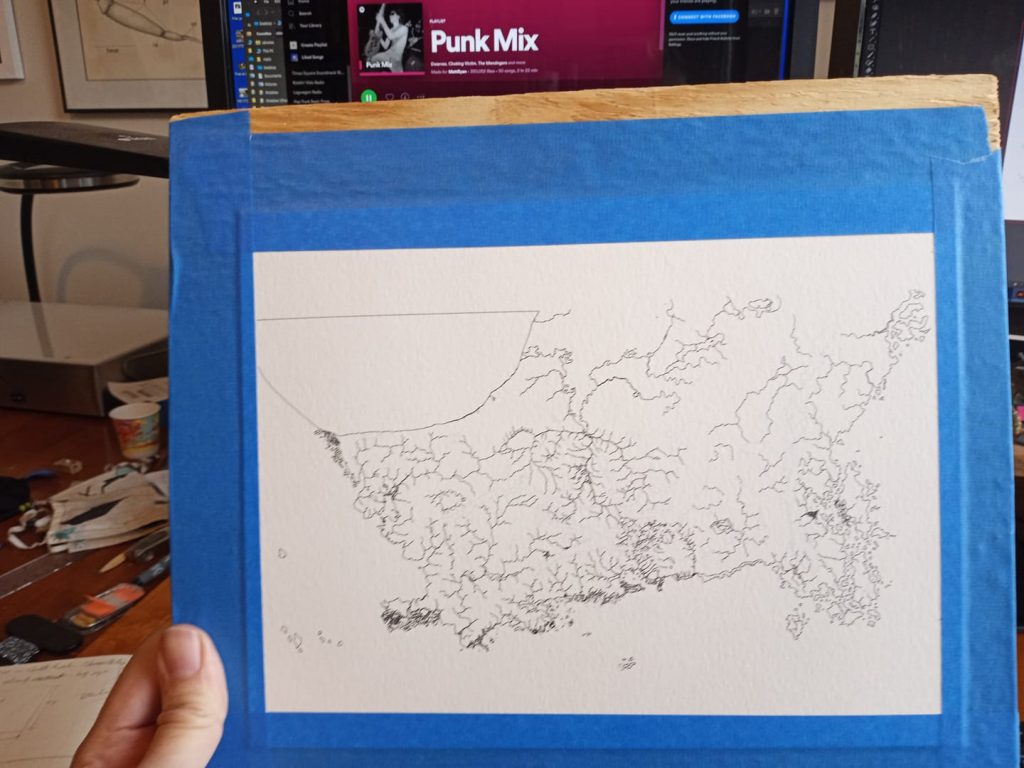
Chaosium’s cartographer is apparently painting a small Genertelan overview for the upcoming cults book, using some good old traditional media! (“watercolour wash, and then gouache for details”) While listening to punk music!
Small Stories
The Beer With Teeth has a great little treat this week, as Diana “Berra” Probst gets a prompt to write “small stories”. They’re absolutely delightful, and I absolutely love the 3rd, 4th, and last ones!
The Runes the Govern and Shape All Things
SkullDixon muses on his blog about the role of Runes in Glorantha and how they can be used to help create stories around the table. The first Rune to look at is Disorder, and it sounds like this is the beginning of a series, with more to come in the near future…
Conduct of Non-Injury
Over at the Eight Arms And The Mask blog, Effy has the story of how Chalana Arroy came to be in the universe, in parallel with a slice of a healer’s life. This might give you ideas for playing initiates of this cult!
Thank you for reading
That’s it for this week! Please contact us with any feedback, question, or news item we’ve missed!


